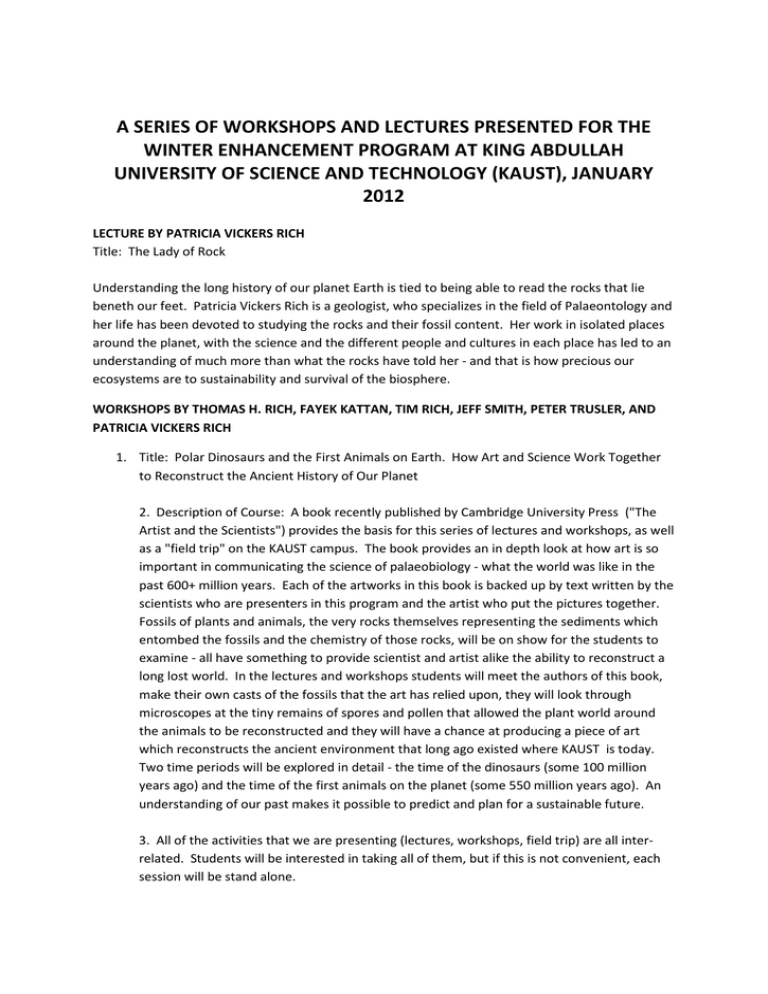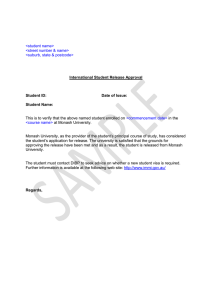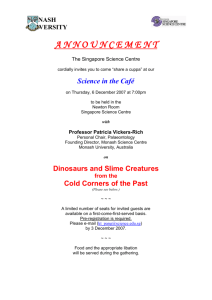Lectures for King Abdullah University - Kaust
advertisement

A SERIES OF WORKSHOPS AND LECTURES PRESENTED FOR THE WINTER ENHANCEMENT PROGRAM AT KING ABDULLAH UNIVERSITY OF SCIENCE AND TECHNOLOGY (KAUST), JANUARY 2012 LECTURE BY PATRICIA VICKERS RICH Title: The Lady of Rock Understanding the long history of our planet Earth is tied to being able to read the rocks that lie beneth our feet. Patricia Vickers Rich is a geologist, who specializes in the field of Palaeontology and her life has been devoted to studying the rocks and their fossil content. Her work in isolated places around the planet, with the science and the different people and cultures in each place has led to an understanding of much more than what the rocks have told her - and that is how precious our ecosystems are to sustainability and survival of the biosphere. WORKSHOPS BY THOMAS H. RICH, FAYEK KATTAN, TIM RICH, JEFF SMITH, PETER TRUSLER, AND PATRICIA VICKERS RICH 1. Title: Polar Dinosaurs and the First Animals on Earth. How Art and Science Work Together to Reconstruct the Ancient History of Our Planet 2. Description of Course: A book recently published by Cambridge University Press ("The Artist and the Scientists") provides the basis for this series of lectures and workshops, as well as a "field trip" on the KAUST campus. The book provides an in depth look at how art is so important in communicating the science of palaeobiology - what the world was like in the past 600+ million years. Each of the artworks in this book is backed up by text written by the scientists who are presenters in this program and the artist who put the pictures together. Fossils of plants and animals, the very rocks themselves representing the sediments which entombed the fossils and the chemistry of those rocks, will be on show for the students to examine - all have something to provide scientist and artist alike the ability to reconstruct a long lost world. In the lectures and workshops students will meet the authors of this book, make their own casts of the fossils that the art has relied upon, they will look through microscopes at the tiny remains of spores and pollen that allowed the plant world around the animals to be reconstructed and they will have a chance at producing a piece of art which reconstructs the ancient environment that long ago existed where KAUST is today. Two time periods will be explored in detail - the time of the dinosaurs (some 100 million years ago) and the time of the first animals on the planet (some 550 million years ago). An understanding of our past makes it possible to predict and plan for a sustainable future. 3. All of the activities that we are presenting (lectures, workshops, field trip) are all interrelated. Students will be interested in taking all of them, but if this is not convenient, each session will be stand alone. 4. Biographies Dr Tom Rich is curator of palaeontology at Museum Victoria in Melbourne, Australia. He has led expeditions around the world, in the Antarctic, in North America, in Australia, and taken part in expeditions in Saudi Arabia and elsewhere. He is interested in fossil mammals, especially those that lived during the time of the dinosaurs, the Mesozoic. He has written many books. Mr Tim Rich is a fossil technician working on preparing fossils from Australia that are over 100 million years old and will be in charge of the casting operation (each student will go away with their own fossil collection!). He is working on a PhD in politics at Monash University in Melbourne with his interest in the Middle East. He enjoys, as a hobby, constructing and painting models and has been involved in field expeditions in South America, Australia and Saudi Arabia. Dr Fayek Kattan is a geologist who works with the Saudi Geological Survey. His long term interest has been the Arabian Shield, which makes up much of the NW part of the Kingdom. Dr Rich, Tim Rich, and Patricia Vickers-Rich have worked with him in the field in the Kingdom for many years in search of the Earth's oldest animals, the Ediacarans, which students will meet in the program presented in this program. Jeff Smith, is a botanist and teacher of conservation biology, who has also been involved in exhibitions related to paleontology. Peter Trusler is a graduate student in geology at Monash University and the artist who has rendered the art work to be presented at this Winter Enhancement Program. He has been painting since he was 14 and also finished his undergraduate degree at Monash University in Zoology. He is not only a brilliant artist but likewise a superb anatomist and has a lifelong interest in birds. Dr Patricia Vickers Rich is the Founding Director of the Monash Science Centre and Professor of Palaeontology in the School of Geosciences , both at Monash University in Melbourne. When she was 4 years old, she made an enormous insect collection, so has been interested in science since a young girl. She has led several expeditions in Saudi Arabia and elsewhere in the world in search of ancient birds, dinosaurs and now the Earth's first animals. She is also interested in teaching science to young children. 5. Photos attached of everyone except Dr Kattan. Could you please contact him for that? 6. One website that would be useful will be that which relates to the first animals on Earth, the Ediacarans. This concerns two UNESCO International Geological Correlation Projects (IGCP493 and 587) which are chaired by Prof. Patricia Vickers-Rich: www.geosci.monash.edu.au/precsite 7. Audio-visual and Materials needed. We will need a data projector and compatible computer. We will bring our own computers but they may not interface with the data projector there. Microscopes - is it possible to have some 400x microscopes where we can show the students slides with pollen and spores, and also some lower power binocular scopes so they can look at some of the small mammal and dinosaur fossils that we will bring. Plaster of Paris - we will need several kg of this white powder that can be mixed with water and which will set quickly. Dentists use this. We will bring moulds of many fossils and the students will be able to make casts of dinosaurs and some of the world's first animals and will be able to take these away for their own collections. Paint brushes, paper upon which to paint, etc. I will have both Tim Rich and Peter Trusler (via doco recording prepared by Steven Pritchard) give a specific list of material that students will need to produce their own reconstruction and accurately paint the casts that they have produced. 8. Tasks for the students. These will be explained as we present. I can send you a CD that gives background for both the dinosaurs (The Terrible Lizards of Oz), which lived near the south pole and another (First Life by David Attenborough and Atlantic Productions), which provides a look into the life and times of the Earth's first animals. 9. Presentations will be videotaped.


